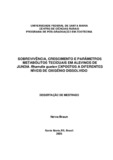| dc.creator | Braun, Neiva | |
| dc.date.accessioned | 2007-02-16 | |
| dc.date.available | 2007-02-16 | |
| dc.date.issued | 2005-02-22 | |
| dc.identifier.citation | BRAUN, Neiva. SURVIVAL, GROWTH AND BIOCHEMICAL PARAMETERS TISSUE OF SILVER CATFISH FINGERLINGS Rhamdia quelen EXPOSED AT DIFFERENT LEVELS OF DISSOLVED OXYGEN. 2005. 46 f. Dissertação (Mestrado em Zootecnia) - Universidade Federal de Santa Maria, Santa Maria, 2005. | por |
| dc.identifier.uri | http://repositorio.ufsm.br/handle/1/10790 | |
| dc.description.abstract | The objective of this study was to verify survival and growth of silver catfish (Rhamdia quelen) fingerlings in different concentrations of dissolved oxygen, as well as its effect on glycogen, glucose, and protein in the liver, kidney, and muscle and activity of the hepatic catalase. In the first experiment 10 fingerlings were used (2.23 ± 0.13 g) in each experimental unit (2 liters) for determination of the lethal concentration (LC-50) in 96 hours for dissolved oxygen. Fingerlings were exposed to 0.40 ± 0.05, 0.76 ± 0.07, 1.04 ± 0.14, and 1.68 ± 0.32 mg/L of dissolved oxygen (three replicates per treatment). In the second experiment 10 fingerlings (4.99 ± 0.18 g) were used for experimental unit (40 liters), and were exposed to 1.96 ± 0.08, 3.10 ± 0.10, 4.14 ± 0.09, 5.20 ± 0.07, and 6.16 ± 0.03 mg/L of dissolved oxygen (three replicates per treatment) for 30 days. LC50 was 0.52 mg/L (confidence interval 0.42 - 0.61). In the growth experiment positive correlation was observed between dissolved oxygen and standard length, weight, specific growth rate, and biomass, and negative correlation for food conversion and catalase. Levels of hepatic glycogen reduced with the increase of oxygen levels. Glucose and the lactate showed variable levels. In the muscular tissue, glicogen levels decreased with the increase of oxygen concentration and glucose and lactate presented variations in the different treatments. There was no significant difference among treatments in the renal glycogen levels, either protein levels of the studied tissues. The best oxygen level for development of silver catfish is above 4.3 mg/L of dissolved oxygen. | eng |
| dc.format | application/pdf | por |
| dc.language | por | por |
| dc.publisher | Universidade Federal de Santa Maria | por |
| dc.rights | Acesso Aberto | por |
| dc.subject | Oxigênio dissolvido | por |
| dc.subject | Jundiá | por |
| dc.subject | Rhamdia quelen | por |
| dc.subject | Crescimento | por |
| dc.subject | Parâmetros bioquímicos | por |
| dc.subject | Dissolved oxygen | eng |
| dc.subject | Silver catfish | eng |
| dc.subject | Rhamdia quelen | eng |
| dc.subject | Growth | eng |
| dc.subject | Biochemical parameters | eng |
| dc.title | Sobrevivência, crescimento e parâmetros metabólitos teciduais em alevinos de jundiá Rhamdia quelen expostos a diferentes níveis de oxigênio dissolvido | por |
| dc.title.alternative | Survival, growth and biochemical parameters tissue of silver catfish fingerlings Rhamdia quelen exposed at different levels of dissolved oxygen | eng |
| dc.type | Dissertação | por |
| dc.description.resumo | Este trabalho teve como objetivo verificar a sobrevivência e o crescimento de alevinos de jundiá (Rhamdia quelen) em diferentes concentrações de oxigênio dissolvido, bem como o seu efeito nos níveis de glicogênio, glicose, proteína no fígado, rim, músculo e a atividade da catalase hepática. No primeiro experimento foram utilizados 10 alevinos (2,23 ± 0,13 g) por unidade experimental (2 litros) para determinação da concentração letal (CL-50) em 96 horas para oxigênio dissolvido. Foram expostos a 0,40 ± 0,05; 0,76 ± 0,07; 1,04 ± 0,14 e 1,68 ±0,32 mg/L de oxigênio dissolvido (três repetições por tratamento). No segundo experimento 10 alevinos (4,99 ± 0,18 g) por unidade experimental (40 litros) foram expostos a 1,96 ± 0,08; 3,10 ± 0,10; 4,14 ± 0,09; 5,20 ± 0,07 e 6,16 ± 0,03 mg/L de oxigênio dissolvido (três repetições por tratamento) por 30 dias. A CL50 foi 0,52 mg/L (intervalo de confiança 0,42 - 0,61). No experimento de crescimento observou-se correlação positiva entre oxigênio dissolvido e comprimento padrão, peso, taxa de crescimento específico, biomassa e correlação negativa na conversão alimentar e catalase. Os níveis de glicogênio hepático apresentaram redução com o aumento da concentração de oxigênio. A glicose e o lactato apresentaram níveis variados. No tecido muscular, os níveis de glicogênio diminuíram com o aumento da concentração de oxigênio e a glicose e lactato apresentaram variações nos diferentes tratamentos. No tecido renal não foi observada diferença no conteúdo de glicogênio. As proteínas do tecido hepático, muscular e renal não apresentaram variações entre os tratamentos. A faixa ideal para o desenvolvimento de alevinos de jundiá é acima de 4,3 mg/L de oxigênio dissolvido. | por |
| dc.contributor.advisor1 | Baldisserotto, Bernardo | |
| dc.contributor.advisor1Lattes | http://buscatextual.cnpq.br/buscatextual/visualizacv.do?id=K4787286P0 | por |
| dc.contributor.referee1 | Schetinger, Maria Rosa Chitolina | |
| dc.creator.Lattes | http://buscatextual.cnpq.br/buscatextual/visualizacv.do?id=K4775370Y4 | por |
| dc.publisher.country | BR | por |
| dc.publisher.department | Zootecnia | por |
| dc.publisher.initials | UFSM | por |
| dc.publisher.program | Programa de Pós-Graduação em Zootecnia | por |
| dc.subject.cnpq | CNPQ::CIENCIAS AGRARIAS::ZOOTECNIA | por |


